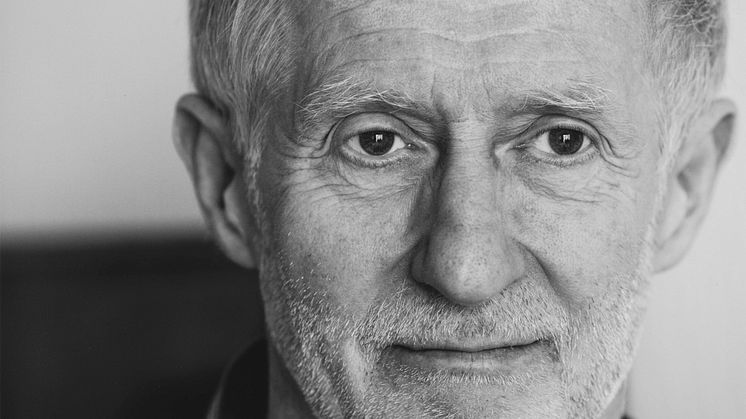
Press release -
Mats Ek this year’s Portrait of Honour
Saturday 15 November will see the unveiling of the 2014 Portrait of Honour at Gripsholm Castle. This year, choreographer and director Mats Ek has been captured by photographer Lesley Leslie-Spinks. Mats Ek is renowned for his new interpretations of ballet classics, most recently in the acclaimed Juliet and Romeo.
This year’s sitter for the Portrait of Honour is the world-famous Swedish choreographer and director Mats Ek (born 1945). He grew up in an artistic family with two parents who were both well-known figures in theatre and dance. It is therefore not surprising that Mats Ek has swung between the worlds of theatre and dance. He has, however, achieved his greatest successes as a choreographer. The Cullberg Ballet and Mats Ek are now drawing in audiences all over the world. His interpretations of classics such as Giselle, Swan Lake and Sleeping Beauty make regular appearances on international dance stages. Most recently, Mats Ek created a masterpiece in the ballet Juliet and Romeo (2013), which has already taken on the status of a classic.
Mats Ek has built on a tradition inherited from his mother Birgit Cullberg, where classical ballet is blended with modernist expressiveness. He has developed an alphabet of movements with his own inimitable signature, such as the straight hand that extends the dancer’s arm or the curiously angled feet. With his varied background, Mats Ek transcends genres and likes to use elements of spoken theatre. Conversely, as a director he has also choreographed theatre. Mats Ek’s choreography feeds on everyday reality, but transforms it with a large dose of humour or crosses it with lofty, often fairytale subjects. He paints in strong colours, often in images, and so set design has also played a major role. He has enjoyed a particularly successful collaboration with the artist Marie-Louise Ekman. Their joint reinterpretations of several classics clearly highlight the fragility of the human condition, love and longing. Over the years, his dance has increasingly been defined by a lightness of touch, technical strength and perfection. All ornamentation gives way to simplicity. Mats Ek’s underlying approach is well developed, but without a definitive form or an end.
Lesley Leslie-Spinks (born 1946) is one of Sweden’s best-known performing arts photographers. She was born and raised in Canada, but came to Europe in 1968 in the company of her then husband, dancer Jeremy Leslie-Spinks. She began photographing dance and quickly developed a special ability to capture the perfect moment. Lesley Leslie-Spinks has been following Mats Ek and the Cullberg Ballet since 1976, but has also worked as a performing arts photographer for Stockholms Stadsteater and others. For Lesley Leslie-Spinks, working with the camera has been a way to explore and understand the world as perceived through dance. At the same time, she has become part of a tradition that began in Sweden in the 1950s, which raises performing arts photography from documentation to its own art form, on a par with the finest in visual art. A splendid summary of work by her and Mats Ek can be found in the magnificent volume Mats Ek, published in 2011 in collaboration with Margareta Sörenson, dance and theatre critic of the Expressen newspaper. This richly illustrated book contains a sample not only of Mats Ek’s varied stage output, but also of Lesley Leslie-Spinks’ outstanding work as a performing arts photographer.
Lesley Leslie-Spinks has never been a portraitist in the conventional sense, although in her capacity as performing arts photographer, she has documented many different sides of human nature. Like all photographers, she has attempted to capture the moment and, in the portrait of Mats Ek, the encounter between her and her model appears to have a truth about it. The master choreographer has a soulful and meditative look. It has become a visionary portrait of the artist. In the pupil, we see not only a window, but the photographer herself. A portrait of two artists who have closely followed each other for almost 40 years.
Press coverage
The
portrait will be unveiled at the Gripsholm Castle Association’s annual meeting,
which begins at 10.30 am on Saturday 15 November at Gripsholm Castle. Both Mats
Ek and Lesley
Leslie-Spinks will attend the
unveiling, and after that take part of a panel discussion moderated by Margareta Sörenson from Expressen. For press
registration, contact Timmy Cox, First Supervisor Gripsholm Castle, The Royal Court, timmy.cox@royalcourt.se or +46 (0)8-402 85
70.
Press contact
Hanna
Tottmar, press officer Nationalmuseum
hanna.tottmar@nationalmuseum.se, +46 (0)767-23 46
32
Caption
©
Lesley Leslie-Spinks, Mats Ek,
choreographer and director.
Categories
The National Portrait Gallery at Gripsholm Castle, the world’s oldest national portrait gallery, was founded in 1822 and is managed by Nationalmuseum. A number of works are added to the collection each year, including an annual Portrait of Honour, donated by Gripsholmsföreningen, depicting a distinguished Swedish citizen.

